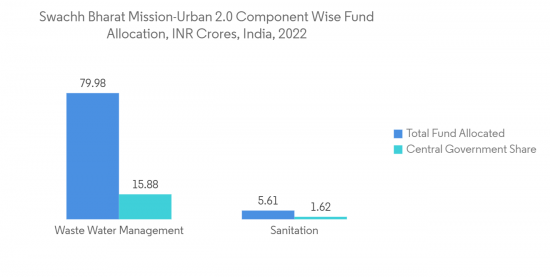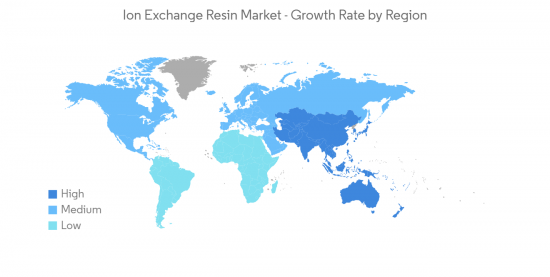 |
市场调查报告书
商品编码
1331356
离子交换树脂市场规模和份额分析-增长趋势和预测(2023-2028)Ion Exchange Resin Market Size & Share Analysis - Growth Trends & Forecasts (2023 - 2028) |
||||||
※ 本网页内容可能与最新版本有所差异。详细情况请与我们联繫。
离子交换树脂市场规模预计将从2023年的12.7亿美元增长到2028年的15.9亿美元,预测期内(2023-2028年)复合年增长率为4.62%。我是。
市场受到了 COVID-19 的负面影响。 这场大流行导致世界上多个国家进入封锁状态,以遏制病毒的传播。 众多公司和工厂的关闭扰乱了全球供应链,损害了全球生产、交货时间和产品销售。 目前,市场已从 COVID-19 大流行中恢復并正在显着增长。
主要亮点
- 中期市场增长的主要推动力是水处理行业的增长以及电子和製药行业对超纯水的需求不断增长。
- 相反,离子交换树脂的细菌污染可能会阻碍所研究市场的增长。
- 燃料电池需求的增加预计将为所研究的市场提供增长机会。
- 亚太地区占据市场主导地位,其中中国和印度是最大的消费者。 此外,亚太地区可能在预测期内实现最快的增长率。
离子交换树脂市场趋势
水处理领域引领市场
- 离子交换树脂通常用作水处理剂,用于去除水中的痕量金属离子、有机化合物和污染物。
- 由于对淡水资源的强劲需求,水处理应用最近有所增加。 水回收是废水处理厂的一个多步骤过程。 离子交换处理工艺通常用于水软化和海水淡化。 它还用于在脱碱、去离子和消毒等过程中去除水中的其他物质。 它们用于工业和市政应用。
- 最近,离子交换树脂越来越多地用于饮用水。 特殊树脂设计用于处理高氯酸盐和铀等各种污染物。
- 还有许多树脂旨在去除硝酸盐和高氯酸盐,例如强碱/强阴离子树脂。 还有树脂珠可用于软化水。
- 树脂材料的交换容量是有限的。 随着长期使用,个别更换部位会变满。 当离子交换不再可能时,树脂必须充电或再生以将其恢復到初始状态。 用于此的物质包括氯化钠、盐酸、硫酸和氢氧化钠。
- 用过的再生剂是该过程中留下的主要材料。 这不仅包括去除的所有离子,还包括具有高总溶解固体含量的额外再生剂。 这种再生剂可以在市政废水处理设施中进行处理,但废水可能需要监测。
- 水处理中离子交换的有效性可能会受到矿物质结垢、表面堵塞和其他导致树脂结垢的问题的限制。 过滤和化学添加等预处理步骤有助于减少或防止这些问题。
- 德国拥有欧洲最大的工业废水处理市场,拥有约 3,000 个处理厂。 每年有超过9.2亿立方米的工业废水经过国内处理后排放到外部环境。
- 由于美国和其他地区的饮料和製药行业对处理水的需求量很大,北美水和废水处理市场也在快速增长。 Lakeshore 废水处理厂扩建项目耗资 4300 万美元,涉及加拿大安大略省废水处理厂的开发。 预计将于 2021 年第四季度开始施工,并于 2023 年第二季度竣工。 该项目旨在解决该地区的废水和污水需求。 该项目预计吞吐量将增加70%。
- 由于全球水处理需求不断增长,预计离子交换树脂的需求将在预测期内增长。

亚太地区主导市场
- 预计亚太地区将在预测期内主导全球离子交换树脂市场。
- 中国离子交换树脂出口主要销往美国,美国是全球最大的出口国。 在中国,水处理应用对离子交换树脂的需求正在快速增长。 食品和饮料、化学、製药和电力行业对更高纯度和更清洁树脂的需求不断增长,以及投资于技术和研发的公司正在推动市场的增长。我在这里。
- 在亚太地区,中国是最大的水消费国。 有水处理厂10113座,处理95%的城市污水和30%的农村污水。 此外,中国计划在2021年至2025年期间建设或升级8万公里的污水收集管网,增加污水处理能力2000万立方米/日。
- 在“十四五”规划中,中国公布了新的废水回用指南,要求提高废水比例。 到 2025 年,必须回收高达 25% 的废物。
- 此外,印度是世界上最大的用水国之一,每年消耗约 7,400 亿日元以满足需求。 需要1亿立方米的水。 然而,地下水枯竭和用水需求增加增加了该国对水处理的依赖。
- 在韩国,2023 年 2 月,SK E□□coplant 宣布通过生产超纯水的核心技术本地化,扩大其在水行业的产品组合。 公司与专门从事膜製造和加工的韩国公司Sepratek签署研发协议,投资超纯水(UPW)核心技术。
- 预计上述因素将在预测期内推动亚太地区对离子交换树脂的需求。

离子交换树脂行业概况
离子交换树脂市场得到整合,各大公司占据了全球主要市场份额。 市场上的知名企业包括DuPont, LANXESS, Ecolab, Mitsubishi Chemical Corporation, and Jacobi Carbons Group等。
其他好处
- Excel 格式的市场预测 (ME) 表
- 3 个月的分析师支持
目录
第 1 章简介
- 调查的先决条件
- 调查范围
第 2 章研究方法
第 3 章执行摘要
第 4 章市场动态
- 促进因素
- 电子和製药行业对超纯水的需求不断增加
- 废水处理行业的发展
- 其他司机
- 抑制因素
- 离子交换树脂的细菌污染
- 其他抑制因素
- 行业价值链分析
- 波特五力分析
- 供应商的议价能力
- 消费者议价能力
- 新进入者的威胁
- 替代品的威胁
- 竞争程度
第 5 章市场细分(基于金额、市场规模)
- 类型
- 通用树脂
- 特种树脂
- 应用
- 医学
- 食品和饮料
- 水处理
- 采矿和冶金
- 化学处理
- 电力
- 其他用途
- 地区
- 亚太地区
- 中国
- 印度
- 日本
- 韩国
- 东盟国家
- 其他亚太地区
- 北美
- 美国
- 加拿大
- 墨西哥
- 欧洲
- 德国
- 英国
- 意大利
- 法国
- 欧洲其他地区
- 南美洲
- 巴西
- 阿根廷
- 南美洲其他地区
- 中东/非洲
- 沙特阿拉伯
- 南非
- 其他中东和非洲地区
- 亚太地区
第 6 章竞争态势
- 併购、合资企业、联盟、协议
- 市场份额 (%)/排名分析
- 各大公司的战略
- 公司简介
- Anhui Samsung Resin Co. Ltd
- Bio-rad Laboratories Inc.
- Doshion Polyscience Pvt. Ltd
- Dupont
- Ecolab
- Eichrom Technologies Llc
- Evoqua Water Technologies Llc
- Ion Exchange(India)Ltd
- Jacobi Carbons Group
- Lanxess
- Mitsubishi Chemical Corporation
- Novasep
- Protech Water India
- Pure Resin Co. Ltd
- Resintech Inc.
- Samyang Corporation
- Sunresin New Materials Co. Ltd
- Suqing Group
- Suzhou Bojie Resin Technology Co. Ltd
- Thermax Limited
第 7 章市场机会和未来趋势
The Ion Exchange Resin Market size is expected to grow from USD 1.27 billion in 2023 to USD 1.59 billion by 2028, at a CAGR of 4.62% during the forecast period (2023-2028).
The market was negatively impacted due to COVID-19. Owing to the pandemic, several countries worldwide went into lockdown to curb the spread of the virus. The shutdown of numerous companies and factories disrupted worldwide supply networks and harmed global production, delivery schedules, and product sales. Currently, the market recovered from the COVID-19 pandemic and is increasing significantly.
Key Highlights
- Over the medium term, the major factors driving the market's growth are the growing water treatment industry and the increasing demand for ultra-pure water from the electronics or pharmaceutical industry.
- Conversely, bacterial contamination caused by ion exchange resins will likely hinder the studied market's growth.
- Growing demand for fuel cells is expected to offer growth opportunities to the market studied.
- Asia-Pacific dominated the market, with the largest consumption coming from China and India. Also, Asia-Pacific will likely register the fastest growth rate during the forecast period.
Ion Exchange Resin Market Trends
Water Treatment Segment to Drive the Market
- Ion exchange resins are commonly used as a water treatment agent to remove trace metal ions, organic compounds, and pollutants from water.
- Water treatment applications are increasing lately, owing to the strong demand for freshwater resources. Water recycling is a multi-stage process in wastewater treatment plants. The ion exchange treatment process is commonly used for water softening or demineralization. It is also used for removing other substances from water in processes such as de-alkalization, de-ionization, and disinfection. These are used for both industrial and municipal purposes.
- Recently, ion exchange resins is increasingly used to create drinking water. Specialized resins are designed to treat various contaminants, including perchlorate and uranium.
- Many resins, such as strong base/strong anion resin, are designed to remove nitrates and perchlorate. There are also resin beads that can be used for water softening.
- Resin materials contain a finite exchange capacity. Each of the individual exchange sites will become full with prolonged use. When it is impossible to exchange ions, the resin must be recharged or regenerated to restore it to its initial condition. The substances used for this include sodium chloride, hydrochloric acid, sulfuric acid, or sodium hydroxide.
- The spent regenerant is the primary substance remaining from the process. It contains not only all the ions removed but also extra regenerations with high total dissolved solids. It can be treated in a municipal wastewater facility, while discharges may require monitoring.
- The efficacy of ion exchange for water treatment can be limited by mineral scaling, surface clogging, and other issues contributing to resin fouling. Pretreatment processes such as filtration or adding chemicals can help reduce or prevent these issues.
- Germany includes Europe's largest industrial wastewater treatment market, with almost 3,000 treatment plants. Over 920 million cubic meters of industrial wastewater are treated annually in the country before being discharged to the outside environment.
- The North American water and wastewater treatment market is also rapidly growing due to the high demand for treated water from the beverage and pharmaceutical industries in countries such as the United States. Expansion of the Lakeshore Wastewater Treatment Plant, a USD 43 million project, entails the development of a wastewater treatment plant in Ontario, Canada. Construction began in Q4 2021 and is expected to complete in Q2 2023. The project aims to address the region's wastewater and sewage needs. The project is expected to increase the capacity by 70%.
- With the increasing need for water treatment globally, the demand for ion exchange resins is projected to grow through the forecast period.

Asia-pacific to Dominate the Market
- Asia-Pacific is expected to dominate the global ion exchange resin market during the forecast period.
- China exports ion exchange resin mainly to the United States and is the largest exporter globally. In China, the demand for ion exchange resins for the applications in water treatment applications is growing at a fast pace. The increasing demand for purer and cleaner resins for usage in food and beverages, chemical, pharmaceutical, and power industries and companies investing in technology and R&D shall augment the market growth.
- In the Asia-Pacific region, China is the largest water consumer country. It contains 10,113 water treatment plants that treat wastewater for 95% of municipalities and 30% of rural areas. Moreover, China plans to build or renovate 80,000 km of sewage collection pipeline networks and increase sewage treatment capacity by 20 million cubic meters/day between 2021-2025.
- In the 14th Five-year Plan, China published new guidelines for wastewater reuse, which mandated increasing the proportion of sewage. It must be treated to reuse standards to 25% by 2025.
- Furthermore, India is among the largest water consumers in the world and needs around 740 billion cubic meters of water per year to meet the demand. However, depleting groundwater and increasing water demand are driving the dependency on water treatment in the country.
- In South Korea, in February 2023, SK Ecoplant Co. announced the expansion of its portfolio in the water industry through localizing core technology to produce ultrapure water. The company signed an R&D agreement with Sepratek, a Korean company specializing in membrane manufacturing and processes, to invest in core technologies for ultrapure water (UPW).
- The above factors are expected to drive the demand for Ion-exchange resins in the Asia-Pacific region during the forecast period.

Ion Exchange Resin Industry Overview
The ion exchange resin market is consolidated, with top players accounting for a major global market share. Some prominent players in the market include DuPont, LANXESS, Ecolab, Mitsubishi Chemical Corporation, and Jacobi Carbons Group, among others.
Additional Benefits:
- The market estimate (ME) sheet in Excel format
- 3 months of analyst support
TABLE OF CONTENTS
1 INTRODUCTION
- 1.1 Study Assumptions
- 1.2 Scope of the Study
2 RESEARCH METHODOLOGY
3 EXECUTIVE SUMMARY
4 MARKET DYNAMICS
- 4.1 Drivers
- 4.1.1 Increasing Demand For Ultra Pure Water From Electronics Or Pharmaceutical Industry
- 4.1.2 Growing Wastewater Treatment Industry
- 4.1.3 Other Drivers
- 4.2 Restraints
- 4.2.1 Bacterial Contamination Caused by Ion Exchange Resins
- 4.2.2 Other Restraints
- 4.3 Industry Value Chain Analysis
- 4.4 Porter's Five Forces Analysis
- 4.4.1 Bargaining Power of Suppliers
- 4.4.2 Bargaining Power of Consumers
- 4.4.3 Threat of New Entrants
- 4.4.4 Threat of Substitute Products and Services
- 4.4.5 Degree of Competition
5 MARKET SEGMENTATION (Market Size in Value)
- 5.1 Type
- 5.1.1 Commodity Resins
- 5.1.2 Specialty Resins
- 5.2 Application
- 5.2.1 Pharmaceutical
- 5.2.2 Food and Beverage
- 5.2.3 Water Treatment
- 5.2.4 Mining and Metallurgy
- 5.2.5 Chemical Processing
- 5.2.6 Power
- 5.2.7 Other Applications
- 5.3 Geography
- 5.3.1 Asia-Pacific
- 5.3.1.1 China
- 5.3.1.2 India
- 5.3.1.3 Japan
- 5.3.1.4 South Korea
- 5.3.1.5 ASEAN Countries
- 5.3.1.6 Rest of Asia-Pacific
- 5.3.2 North America
- 5.3.2.1 United States
- 5.3.2.2 Canada
- 5.3.2.3 Mexico
- 5.3.3 Europe
- 5.3.3.1 Germany
- 5.3.3.2 United Kingdom
- 5.3.3.3 Italy
- 5.3.3.4 France
- 5.3.3.5 Rest of Europe
- 5.3.4 South America
- 5.3.4.1 Brazil
- 5.3.4.2 Argentina
- 5.3.4.3 Rest of South America
- 5.3.5 Middle-East and Africa
- 5.3.5.1 Saudi Arabia
- 5.3.5.2 South Africa
- 5.3.5.3 Rest of Middle-East and Africa
- 5.3.1 Asia-Pacific
6 COMPETITIVE LANDSCAPE
- 6.1 Mergers & Acquisitions, Joint Ventures, Collaborations and Agreements
- 6.2 Market Share (%)**/Ranking Analysis
- 6.3 Strategies Adopted by Leading Players
- 6.4 Company Profiles
- 6.4.1 Anhui Samsung Resin Co. Ltd
- 6.4.2 Bio-rad Laboratories Inc.
- 6.4.3 Doshion Polyscience Pvt. Ltd
- 6.4.4 Dupont
- 6.4.5 Ecolab
- 6.4.6 Eichrom Technologies Llc
- 6.4.7 Evoqua Water Technologies Llc
- 6.4.8 Ion Exchange (India) Ltd
- 6.4.9 Jacobi Carbons Group
- 6.4.10 Lanxess
- 6.4.11 Mitsubishi Chemical Corporation
- 6.4.12 Novasep
- 6.4.13 Protech Water India
- 6.4.14 Pure Resin Co. Ltd
- 6.4.15 Resintech Inc.
- 6.4.16 Samyang Corporation
- 6.4.17 Sunresin New Materials Co. Ltd
- 6.4.18 Suqing Group
- 6.4.19 Suzhou Bojie Resin Technology Co. Ltd
- 6.4.20 Thermax Limited
7 MARKET OPPORTUNITIES AND FUTURE TRENDS
- 7.1 Growing Demand For Fuel Cells









